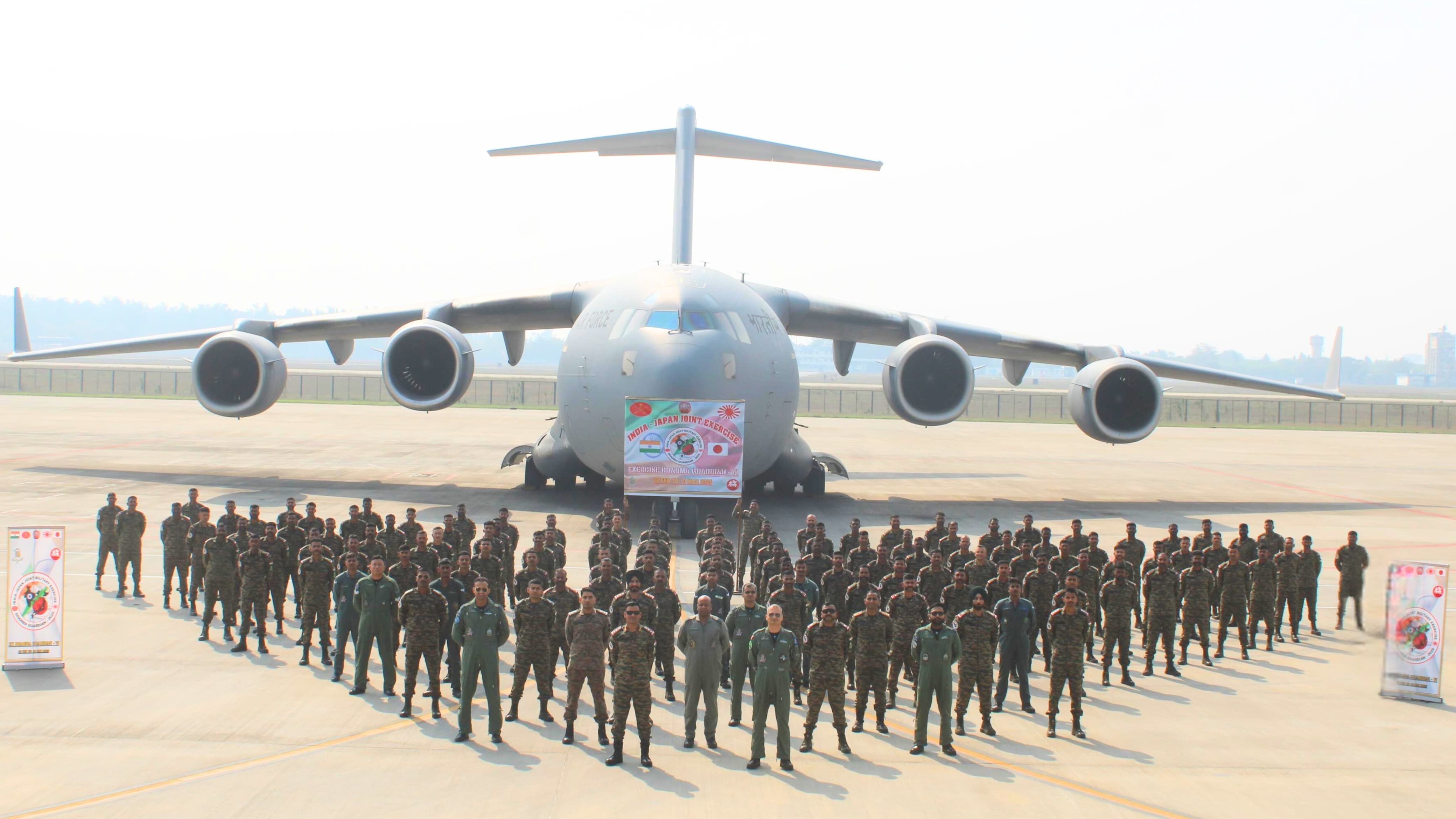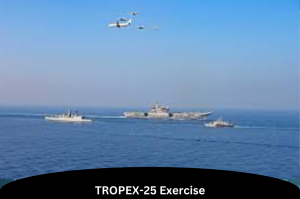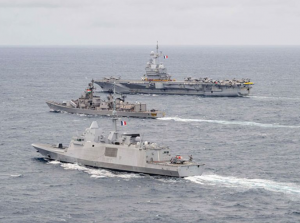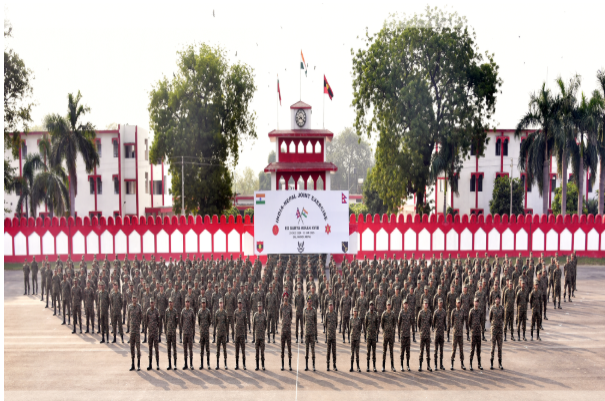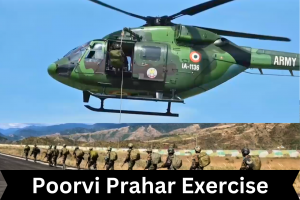Contents
- 1 About DHARMA GUARDIAN Exercise
- 2 About Exercise Komodo
- 3 About COMPACT Initiative
- 4 Key Objectives of the Initiative
- 5 Strategic Significance
- 6 About TROPEX-25
- 7 Strategic Importance
- 8 About Exercise La Perouse
- 9
- 10 About Exercise SURYA KIRAN
- 11 About Exercise SLINEX
- 12 About Exercise CINBAX
- 13 Why in news?
- 14 About Sanyukt Vimochan 2024 Exercise
- 15 Why in news?
- 16 About Poorvi Prahar
DHARMA GUARDIAN Exercise
February 22, 2025↓News: The Indian Army contingent has departed for the 6th edition of India-Japan Joint Military Exercise – DHARMA GUARDIAN, scheduled from 24th February to 9th March 2025 at the East Fuji Manoeuvre Training Area, Japan.
About DHARMA GUARDIAN Exercise
Source: PIB - This is an annual joint military exercise, held alternately in India and Japan. The previous edition (2024) was conducted in Rajasthan, India.
- Participating Forces:
- Indian Contingent: 120 personnel, primarily from a battalion of the MADRAS Regiment includes troops from other arms and services.
- Japanese Contingent: Similar strength from the 34th Infantry Regiment of Japan Ground Self-Defence Force (JGSDF).
- Objectives:
- Enhancing Interoperability between Indian and Japanese forces.
- Joint Urban Warfare & Counter-Terrorism Operations under a UN mandate.
- High Physical Fitness Training, joint planning, and tactical drills.
- Tactical Drills & Disaster Response Strategies to improve operational capabilities.
- Strengthening Defence Cooperation and refining combat skills.
- Significance & Strategic Importance:
- Strengthens Bilateral Defence Relations between India and Japan.
- Builds on the momentum of the Chief of the Army Staff’s visit to Japan (14-17 October 2024).
- Promotes Regional Security & Stability in line with the Indo-Pacific vision.
- Fosters Military & Cultural Ties, reinforcing trust and cooperation.
Exercise Komodo
February 18, 2025↓News: Recently, Indian Navy participated in the International Fleet Review (IFR) 2025 and the Multilateral Naval Exercise Komodo in Indonesia.
About Exercise Komodo
- Exercise Komodo is a multilateral naval exercise hosted by Indonesia.
- It focuses on enhancing maritime security cooperation among participating navies.
- Objectives
- Strengthen maritime interoperability among regional and global navies.
- Enhance coordination in humanitarian assistance and disaster relief (HADR) operations.
- Promote maritime security through collaborative efforts and shared strategies.
- The Indian Navy is participating with INS Shardul and P8I Long-Range Maritime Surveillance aircraft.
- Indian naval forces will take part in tactical floor games, symposiums, and multinational activities.
- This engagement reinforces India’s commitment to regional security and maritime cooperation.
- Activities During Exercise Komodo:
- Naval maneuvers and interoperability drills with other countries.
- Search and rescue exercises for better coordination during emergencies.
- Disaster response simulations to improve regional HADR capabilities.
- Environmental conservation activities, such as coral & mangrove plantation and beach cleaning.
- Significance of the Exercise:
- Strengthens regional security cooperation in the Indo-Pacific.
- Enhances India-Indonesia naval relations and broader multilateral maritime ties.
- Supports the vision of Security and Growth for All in the Region (SAGAR).
- Encourages peaceful and rules-based maritime operations.
COMPACT Initiative
February 17, 2025↓News: US President Donald Trump and Indian Prime Minister Narendra Modi launched the US-India COMPACT (Catalyzing Opportunities for Military Partnership, Accelerated Commerce & Technology) for the 21st Century.
About COMPACT Initiative
- The US-India COMPACT (Catalyzing Opportunities for Military Partnership, Accelerated Commerce & Technology) initiative aims to enhance defence collaboration, facilitate technology transfer, and boost bilateral trade while strengthening strategic ties between the two nations.
Key Objectives of the Initiative
- Strengthening Defence Relations: The initiative marks a significant expansion of US-India defence cooperation, with plans to sign a 10-year Framework for the US-India Major Defence Partnership within the year.
- Advanced Defence Procurements: India is set to increase military purchases worth billions of dollars, including advanced weaponry and military platforms such as the Javelin Anti-Tank Guided Missiles, Stryker Infantry Combat Vehicles, and additional P-8I Maritime Patrol aircraft.
- Potential F-35 Deal: While discussions on acquiring the F-35 stealth fighter jets are in the early stages, this move signals a major step towards advanced aerial defence capabilities for India.
- Technology Transfer & Joint Production: The two nations have agreed to expand defence co-production and explore joint development in areas such as autonomous systems, missile defence, maritime security, and undersea warfare technologies.
- Interoperability & Logistics: The initiative will enhance maintenance, repair, and supply-chain cooperation, ensuring smoother operational capabilities for US-origin defence equipment in India.
Strategic Significance
- The US-India COMPACT aligns with broader geopolitical objectives.
- It is a key driving force behind the agreement is countering China’s growing influence in the Indo-Pacific region.
- The initiative reinforces regional security by enhancing India’s military preparedness and deepening strategic cooperation.
TROPEX-25 Exercise
February 8, 2025↓News: TROPEX-25 Exercise is currently being conducted in the Indian Ocean Region (IOR) from January to March 2025.
About TROPEX-25
- The Theatre Level Operational Exercise (TROPEX) is the Indian Navy’s flagship biennial operational exercise.
- This large-scale exercise involves the active participation of the Indian Navy, Army, Air Force, and Coast Guard, ensuring a coordinated and integrated approach to maritime security.
- Goal: To validate the core warfighting skills of the Indian Navy while ensuring an integrated and synchronized approach to maritime security.
- Aim: The exercise aims to strengthen India’s ability to respond to a contested maritime environment by preparing for:
- Conventional threats posed by enemy naval forces.
- Asymmetric threats such as piracy, terrorism, and unconventional warfare.
- Hybrid threats that combine traditional and non-traditional security challenges.
- Additionally, the exercise seeks to enhance joint operations and interoperability among the Indian Navy, Army, Air Force, and Coast Guard, ensuring a seamless and effective response to potential threats.
- TROPEX-25 is structured into multiple phases, each designed to simulate different aspects of warfare and military operations:
- Harbour Phase: This phase focuses on strategic planning, training, and coordination among participating units before commencing operations at sea.
- Sea Phase: In this stage, naval forces engage in real-time operations, testing their combat readiness in a contested maritime environment.
- Cyber and Electronic Warfare Operations: TROPEX-25 incorporates modern warfare elements, including cyber defense and electronic warfare measures to enhance resilience against digital threats.
- Live Weapon Firings: During this phase, naval units conduct live-fire exercises to test the accuracy and efficiency of their weapon systems.
- Amphibious Exercise: This phase involves coordinated land-sea operations, where naval forces work alongside Army troops to conduct amphibious landings and coastal defence exercises.
Strategic Importance
- TROPEX-25 plays a crucial role in enhancing India’s maritime dominance and regional security in the Indian Ocean.
- The exercise prepares the Indian Armed Forces for joint operations in real-world combat scenarios, ensuring their ability to respond effectively to security challenges.
- It also reinforces India’s ability to project power, safeguard maritime trade routes, and counter emerging threats in the region.
Exercise La Perouse
January 22, 2025↓News: India’s indigenous guided missile destroyer INS Mumbai is participating in the 5th edition of exercise La Perouse.
About Exercise La Perouse
Source- The Tribune - The naval exercise is being organised in the straits between the Indian Ocean and the Pacific Ocean: Malacca, Sunda and Lombok.
- These straits constitute important sea lanes of communication, emphasising their economic and strategic significance.
- The exercise aims to strengthen military safety and develop common maritime situational awareness by enhancing cooperation in the field of maritime surveillance, maritime interdiction operations, air operations.
- Navies from India, France, Indonesia, Australia, US, UK, Malaysia, Singapore, and Canada are participating in the exercise.
- The exercise will feature complex multi-domain exercises like surface warfare, anti-air warfare, air defence, cross deck landings and tactical manoeuvres and VBSS (Visit, Board, Search and Seizure) operations.
Jean-François de Galaup, Comte de La Pérouse - He was a French Navy Officer and one of the greatest French Navigator of the 18th century.
- In 1785, he was entrusted by King Louis XVI to lead a global expedition to complete James Cook’s discoveries in the Pacific and study the possibilities of trade with the countries visited.
- During this global expedition, he commanded two frigates: the Boussole and the Astrolabe.
- The expedition tragically ended in 1788 when the ship wrecked on the reefs of Vanikoro in the Soloman Islands.
- The naval exercise is being organised in the straits between the Indian Ocean and the Pacific Ocean: Malacca, Sunda and Lombok.
Exercise SURYA KIRAN
December 31, 2024↓News: An Indian Army contingent has left for Nepal to take part in the 18th edition of Battalion-Level Joint Military Exercise, SURYA KIRAN.
Source- PIB About Exercise SURYA KIRAN
- It is a bilateral joint military exercise between India and Nepal, conducted annually since 2011.
- The host nation alternates between India and Nepal.
- The 18th edition of the exercise will be held in Saljhandi, Nepal, from 31st December 2024 to 13th January 2025.
- The Indian Army contingent is being led by a battalion from the 11th Gorkha Rifles, while the Nepal Army contingent will be represented by the Srijung Battalion.
- Aim of the exercise:
- To enhance interoperability in jungle warfare.
- To train in counter-terrorism operations in mountainous terrain.
- To provide Humanitarian Assistance and Disaster Relief under the United Nations Charter on peacekeeping operations.
- Significance:
- Provides a platform for soldiers from India and Nepal to exchange ideas and experiences, fostering a deeper understanding of each other’s operational procedures.
- Helps achieve shared security objectives and strengthens bilateral relations between the two friendly neighbors.
Exercise SLINEX
December 17, 2024↓News: Exercise SLINEX 2024 (Sri Lanka–India Exercise) will take place from December 17 to 20, 2024, at Visakhapatnam, under the supervision of the Eastern Naval Command.
About Exercise SLINEX
Source- PIB - It is a bilateral naval exercise between India and Sri Lanka.
- The first SLINEX exercise took place in 2005. The 11th edition took place in 2024.
- The 2024 edition of SLINEX aims to further enhance the strong maritime ties between India and Sri Lanka while promoting a safe, secure, and rules-based maritime environment.
- Participating Units:
- From India: Indian Naval Ship (INS) Sumitra, a Naval Offshore Patrol Vessel of the Eastern Fleet, along with a Special Forces team.
- From Sri Lanka: SLNS Sayura, an Offshore Patrol Vessel, with an embarked Special Forces team.
- The exercise will take place in two phases: the Harbour Phase and the Sea Phase.
- Harbour Phase– Participants will engage in professional and social exchanges to foster mutual understanding.
- Sea Phase- It will include joint exercises such as Special Forces operations, gun firings, communication drills, seamanship practices, navigation evolutions, and helicopter operations.
Exercise CINBAX
December 2, 2024↓News: The 1st edition of Joint Table Top Exercise, CINBAX commenced at Foreign Training Node, Pune.
About Exercise CINBAX
Source- PIB - It is conducted between the Indian Army and the Cambodian Army.
- The Cambodian Army contingent will comprise 20 personnel and the Indian Army contingent is also comprising 20 personnel from an Infantry Brigade.
- It is a planning exercise aimed to wargame conduct of joint Counter Terrorism (CT) operations under Chapter VII of the United Nations Charter.
- The exercise will focus on discussions pertaining to establishment of Joint Training Task Force for intelligence, surveillance and reconnaissance besides planning of operations in counter-terrorism environment.
- The exercise will also involve discussion on information operations, cyber warfare, hybrid warfare, logistics and casualty management, HADR operations etc.
- The exercise will have three phases:
Phase I: Preparation and orientation on CT operations for UN peacekeeping.
Phase II: Tabletop exercises.
Phase III: Finalizing plans and concluding the exercise.- The exercise will also showcase weapons and equipment of the Indian origin promoting ‘Atmanirbharta’ and indigenous capabilities in defence production.
- The inaugural edition of Exercise CINBAX will aim to strengthen trust, camaraderie, and interoperability between the troops of both sides.
Sanyukt Vimochan 2024 Exercise
November 20, 2024↓Source: This post on Sanyukt Vimochan 2024 Exercise has been created based on the article “INDIAN ARMY SUCCESSFULLY CONCLUDES MULTI AGENCY DISASTER RELIEF EXERCISE ‘SANYUKT VIMOCHAN 2024′” published in PIB on 20th November 2024.
Why in news?
Recently, the Indian Army successfully conducted Sanyukt Vimochan 2024 Exercise.
About Sanyukt Vimochan 2024 Exercise
Aspects Description About 1. The Indian Army successfully conducted its Annual Joint Humanitarian Assistance and Disaster Relief (HADR) Exercise, titled ‘Sanyukt Vimochan 2024’.
2. Held in: Ahmedabad and Porbandar, Gujarat.
3. Conducted By: Konark Corps of Southern Command of Indian Army
4. Participants: Included representatives from **nine Friendly Foreign Countries, including nations from the Gulf Cooperation Council (GCC), Indian Ocean Region, and Southeast Asia.Objective To strengthen India’s disaster response capabilities, enhance coordination among multiple agencies during natural disasters, and foster international collaboration in disaster management. Tabletop Exercise (TTX) 1. The Tabletop Exercise (TTX) focused on the theme of a cyclone in the coastal region of Gujarat, specifically targeting the Okha-Porbandar coastline. The simulation addressed disaster scenarios.
2. Aim: To strengthen interagency coordination by brainstorming effective disaster relief strategies.
3. Key outcomes: Identification of gaps in current mechanisms and the development of more robust joint disaster response protocols.Multi-Agency Capability Demonstration 1. The Multi-Agency Capability Demonstration simulated a cyclone scenario to showcase real-world disaster response efforts.
2. The event featured reconnaissance and surveillance of affected areas, personnel insertion for rescue operations, casualty evacuation, and the rehabilitation of affected citizens.Significance 1. ‘Sanyukt Vimochan 2024’ marked a significant step in enhancing India’s disaster response capabilities.
2. The exercise demonstrated the country’s preparedness to handle natural calamities efficiently, strengthened international cooperation, and showcased innovations that contribute to a self-reliant and globally collaborative disaster management framework.UPSC Syllabus: Exercise in news
Poorvi Prahar Exercise
November 19, 2024↓Source: This post on Poorvi Prahar Exercise has been created based on the article “Poorvi Prahar tri-service exercise” published in PIB on 19th November 2024.
Why in news?
Recently, the Poorvi Prahar exercise was conducted in Arunachal Pradesh.
About Poorvi Prahar
Aspects Description About 1. Poorvi Prahar is a tri-service military drill held in the forward areas of Arunachal Pradesh.
2. The exercise spanned from November 10 to November 18, 2024.Objective The primary objective is to enhance combat effectiveness, inter-service coordination, and operational readiness in the challenging mountainous terrain of the region. Key focus 1. Integrated Joint Operations: The exercise emphasized synchronized operations between the Army, Navy, and Air Force. It tested the capability of the armed forces to operate cohesively in a multi-domain, joint command environment. 2. Technological Advancement: Advanced military platforms and next-generation technologies were employed to simulate modern warfare scenarios. The focus was on leveraging cutting-edge tools to strengthen operational capabilities.
3. Operational Readiness: Forces were trained to handle real-world combat scenarios, particularly in the difficult topography of Arunachal Pradesh. The exercise sought to bolster India’s defensive posture along its eastern frontier.
Technology Integration - Advanced Systems and Communication: The exercise featured the use of AI-driven analytics for better battlefield decision-making and satellite communication for seamless real-time information sharing.
- A Common Operating Picture (COP) was developed to ensure effective coordination.
- Innovative Tools: The deployment of swarm and FPV drones enhanced situational awareness and operational flexibility.
- Loitering munitions were used to demonstrate their precision and adaptability in combat scenarios.
- Joint Command Structures: Integrated command structures facilitated seamless cooperation between ground, air, and naval forces.
- Real-time data exchange allowed for agile and coordinated responses to dynamic challenges.
Strategic Significance - Adaptable Defence Posture: Exercise Poorvi Prahar reinforced India’s readiness to counter regional security challenges. It highlighted India’s commitment to maintaining a robust defence along its eastern frontier.
- Military Excellence: The exercise showcased exceptional collaboration across the three services. It also reflected the Indian Armed Forces’ focus on adopting advanced technologies to remain at the forefront of modern warfare.
- Strategic Deterrence: The capabilities demonstrated during the exercise underscored India’s preparedness to execute multi-domain operations. The display of technological prowess and operational agility served to strengthen deterrence measures aimed at safeguarding national interests.
UPSC Syllabus: Science and technology



